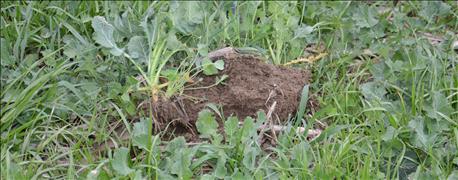
Everyone grew up hearing about the three R's of early education — reading, 'riting and 'rithmetic — but are you aware of the 4 R's of effective and efficient use of fertilizer products provided by The Fertilizer Institute?
The Indiana Conservation Partnership helped compile information to explain the 4 R’s, as well as tips for starting on your spring fertilization strategy now.

RETAIN AND REUSE: Cover crops can take up nutrients and prevent them from being lost to the environment.
Don Donovan and Clint Harrison, district conservationists with the Natural Resources Conservation Service, helped round up this information. In this age of tight financial margins and environmental concern, Donovan knows successful Indiana farmers understand these principles and involve them in their farming operations.
Here are the 4 R’s, as explained by Donovan:
1. Right source. Match your fertilizer type to crop needs. There are many types of fertilizer, including commercial and noncommercial manure. You need to ensure a balanced supply of essential nutrients considering both naturally available sources, and the characteristics of specific products in plant-available forms.
2. Right time. Make nutrients available when crops need them. Make decisions based on the dynamics of crop uptake, soil supply, nutrient loss risks and field operation logistics. When does the crop need the nutrients, and when are they available for uptake? What are the chances for loss prior to uptake? Typically, split applications are more efficient than one application.
3. Right rate. Match the amount of nutrient to crop needs and make decisions based on soil nutrient supply and plant demand. Balance the crop’s needs without running short or putting on too much that may be lost to the environment.
4. Right place. Keep nutrients where crops can use them, and address root-soil dynamics and nutrient movement. Manage the differences and variability within each field to meet the site-specific needs of your crop and limit potential losses from the field.
Current margins in farming don’t leave much room for error, Donovan explains. Adoption of the 4 R's on your operation will go a long way to improve the efficiency of your nutrient applications, letting you grow maximum yields while not impacting the environment, he says.
Spring fertilizer application
Harrison works with farmers who use a fertilizer plan to help maximize their nutrient use efficiency. These plans all start with an up-to-date soil test. If you haven’t tested your soil recently, you may be applying more fertilizer than your crop needs.
Using variable-rate application could also be beneficial to your operation, Harrison says. It puts the right amount of nutrients exactly where they are needed.
Some farmers also wait until spring to spread dry fertilizer. Winter application of dry fertilizer is more at risk from the weather. For instance, surface-applying phosphorus to frozen or snow-covered ground greatly increases the chances of nutrient runoff from winter rains and snowmelt.
These farmers use spring application — just prior to, during or after planting — as their choice to minimize losses to runoff and leaching, Harrison says.
Many farmers also reduce the risk of nutrient runoff by planting cover crops. Cover crops will capture nutrients from fall to spring that may have otherwise left the field and keep them on the farm.
Considering all of these factors in your nutrient plan could save you time and money. Contact your local NRCS office for more information on how to get started on a nutrient management plan, Harrison advises.
About the Author(s)
You May Also Like




